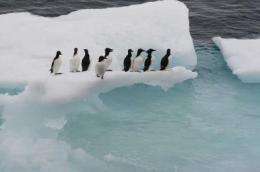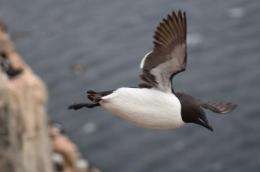These are Brünnich's guillemots on an ice floe at Coats Island in northern Hudson Bay, Canada. Credit: Kyle Elliott
Scientists have found that diving birds reach their 30s and then die quickly and suddenly, showing few signs of aging prior to death. Their findings, which will be presented at the Society for Experimental Biology meeting in Salzburg on 2nd July could help us understand the aging process, providing critical insights for our aging population.
The guillemots – which look similar to penguins but can fly – have the highest flight costs of any bird and expend substantial energy for diving. Their high metabolisms and frequent dives should produce oxidative stress, causing the birds to deteriorate as they age. But, the researchers discovered that the birds stay fit and active as they grow older, maintaining their flying, diving, and foraging abilities.
Brünnich's guillemots have the highest flight costs of any bird. Credit: Kyle Elliott
Kyle Elliott, a PhD student at the University of Manitoba and the study's lead author, said, "Most of what we know about aging is from studies of short-lived round worms, fruit flies, mice, and chickens, but long-lived animals age differently. We need data from long-lived animals, and one good example is long-lived seabirds."
Elliott also said, "Not only do these birds live very long, but they maintain their energetic lifestyle in a very extreme environment into old age."
This clip was filmed at the Brünnich's guillemots research camp on Coats Island, northern Hudson Bay in July-August 2011, with a few stills from earlier years. Credit: Tony Gaston
One bird, nicknamed 'Wayne Gretzky' by the researchers (after the Canadian hockey great who played 20 seasons and because the bird's identification band colours matched Gretzky's team colours), raised young for 18 consecutive years.
Over 4 consecutive summers, researchers periodically tracked Brünnich's guillemots' fitness, recording how deep and for how long they would dive for prey, how far and fast they would fly, and how much energy they expended on these activities. They looked for changes in the birds' behaviour and metabolism.
Provided by Society for Experimental Biology






















